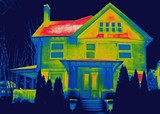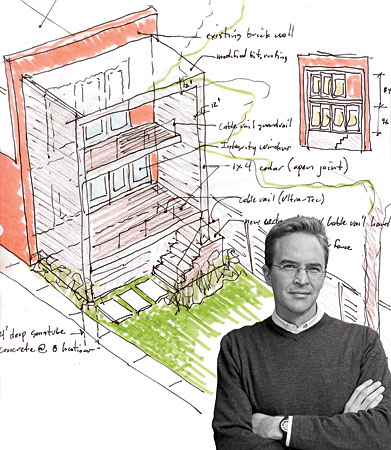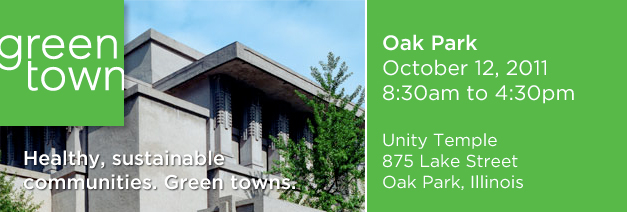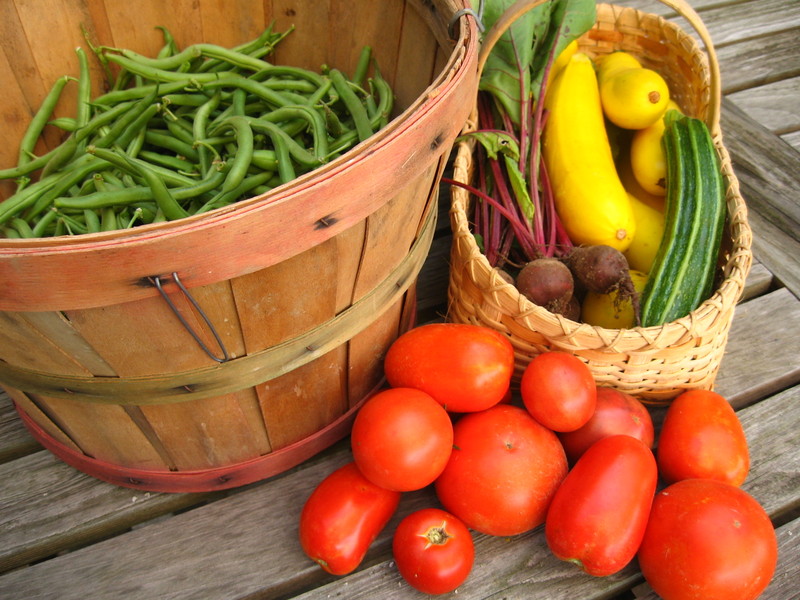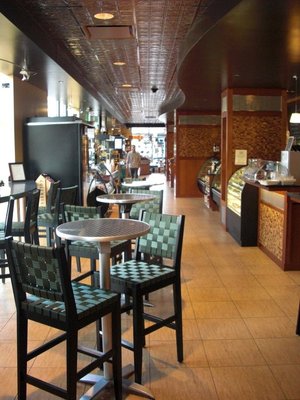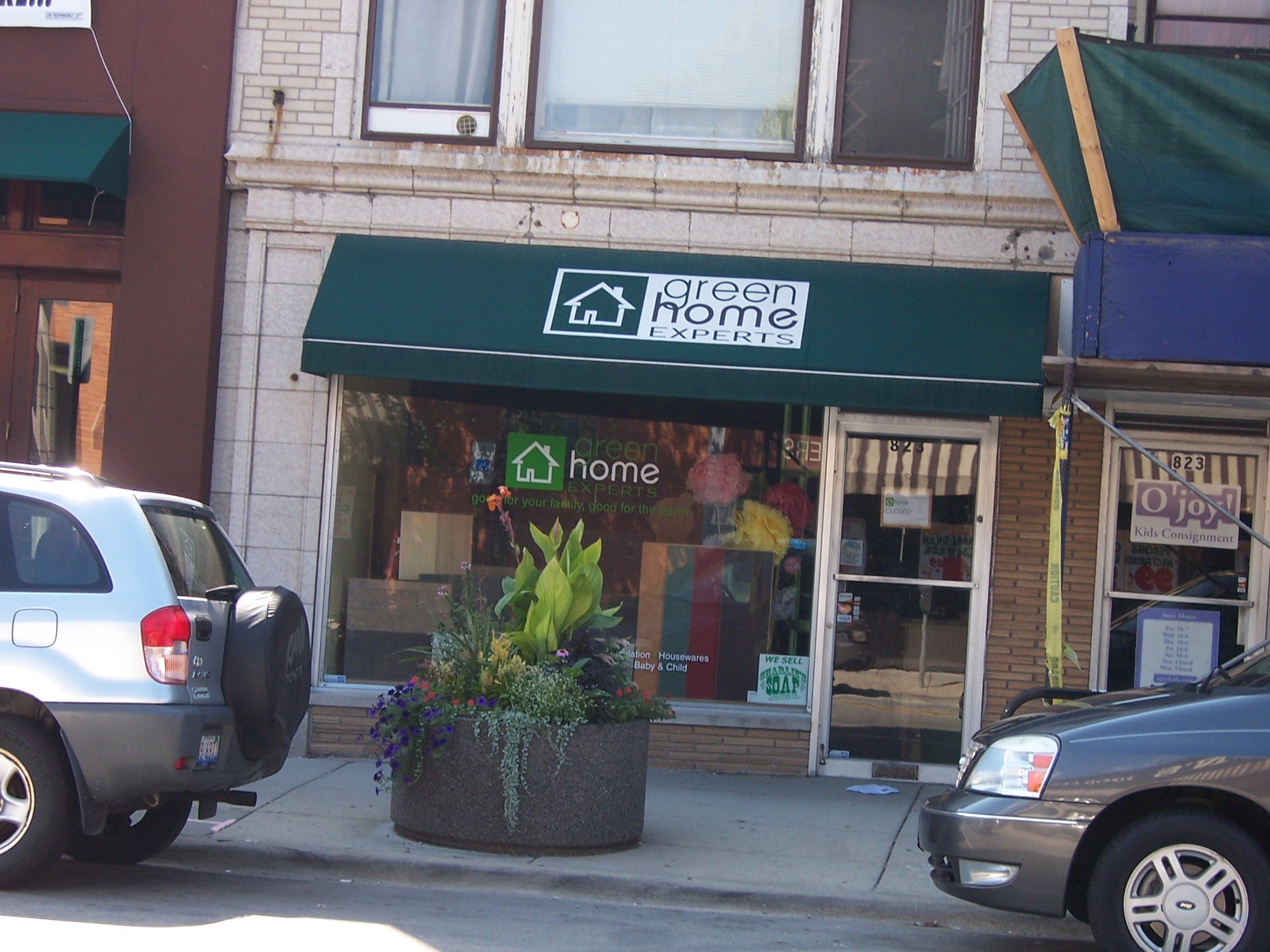 Interview conducted by Sally Simmel with Maria Onesta Moran, owner of Green Home Experts
Interview conducted by Sally Simmel with Maria Onesta Moran, owner of Green Home Experts
The blackboard in front of 823 South Oak Park Avenue screams “We Love Worms.” That’s enough to make you want to go in and see what is happening at Green Home Experts.
It wasn’t my first visit to the store, but the first time I actually had an appointment to talk with the owner, Maria Onesta Moran. As usual, Maria was buzzing around the store, talking with a contractor and then helping a customer find what she needed.
Seven-month-old Oscar, Maria’s son, was happily napping in his comfy carrier. It gave me a chance to walk around a little. There have been some changes in the store in the recent months, making it easy to view materials at a convenient counter and to check out products.
Even as we spoke Maria was unpacking some new supplies for the coming school year. There are all sorts of clever green lunch boxes, food containers and water bottles ready to go for children heading back to school this fall.
Oscar woke and we took turns holding him as we talked about Maria’s big adventure into the green retail world. She had been working in marketing and communications for a non-profit housing facility which provided supportive care in two certified LEED building. She and her husband were living in the W. Loop, setting up house, but not finding a variety of green home products in stores. That led her to see a niche that she might fill in terms of service to homeowners and builders committed to the environment.
So, in February of 2008 Green Home Experts appeared on Oak Park Avenue with a big selection of home, garden, and building supplies, baby and pet care products. If what you need isn’t in the store, Maria knows exactly where to look for it and will help with your choices.
As the economic situation grew more difficult, many people chose to upgrade and redecorate their homes rather than build new or move. Maria assisted by carrying more merchandise like paints and flooring. She was set to unpack a shipment of new paint brushes. Complementary products will make it even more convenient to do one-stop “green” shopping. Home improvement materials at Green Home are beautiful, durable, cost effective, and energy efficient.
Clearly Maria is a woman with a vision that includes providing products and services as well as educational opportunities to the community. It may mean finding more space, a bigger store, but only time will tell. Her goal is to continue to grow. She is very creative in the use of space and display, providing customers with an array of colors, shapes and textures to enjoy as they consider their needs and look for new ways to add environmentally friendly products in their home.
You might start with a small kitchen composter that is attractive and sits on your counter while you consider the value of composting on a larger scale. Or, maybe a rainbarrel appeals to you as a kick-off activity. Collect the water, use it for lawn and indoor plants, dog washing. If you happen to need a new toilet or new windows, explore the advantages of green alternatives.
Also check out the workshops that Maria is offering at Green Home Experts. There will be one on canning this fall. Other regular workshops include such things as gardening, remodeling and energy efficiency. You can find more information on classes, workshops, speakers and products at Green Home Experts web site. But do stop in as well. There’s nothing like experiencing the ambiance and spirit in a place like Green Home Experts.
Oscar’s dad came to pick him up, so we ended our conversation, with a “thanks” and “come again.” I will – often. Thanks, Maria.
Interview with Maria Onesta Moran
The blackboard in front of 823 South Oak Park Avenue screams “We Love Worms.” That’s enough to make you want to go in and see what is happening at Green Home Experts.
It wasn’t my first visit to the store, but the first time I actually had an appointment to talk with the owner, Maria Onesta Moran. As usual, Maria was buzzing around the store, talking with a contractor and then helping a customer find what she needed.
Seven-month-old Oscar, Maria’s son, was happily napping in his comfy carrier. It gave me a chance to walk around a little. There have been some changes in the store in the recent months, making it easy to view materials at a convenient counter and to check out products.
Even as we spoke Maria was unpacking some new supplies for the coming school year. There are all sorts of clever and green lunch boxes, food containers and water bottles ready to go for children heading back to school this fall.
Oscar woke and we took turns holding him as we talked about Maria’s big adventure into the green retail world. She had been working in marketing and communications for a non-profit housing facility which provided supportive care in two certified LEED building. She and her husband were living in the W. Loop, setting up house, but not finding a variety of green home products in stores. That led her to see a niche that she might fill in terms of service to homeowners and builders committed to the environment.
So, in February of 2008 Green Home Experts appeared on Oak Park Avenue with a big selection of home, garden, and building supplies, baby and pet care products. If what you need isn’t in the store, Maria knows exactly where to look for it and will help with your choices.
As the economic situation grew more difficult, many people chose to upgrade and redecorate their homes rather than build new or move. Maria assisted by carrying more merchandise like paints and flooring. She was set to unpack a shipment of new paint brushes. Complementary products will make it even more convenient to do one-stop “green” shopping. Home improvement materials at Green Home are beautiful, durable, cost effective, and energy efficient.
Clearly Maria is a woman with a vision that includes providing products and services as well as educational opportunities to the community. It may mean finding more space, a bigger store, but only time will tell. Her goal is to continue to grow. She is very creative in the use of space and display, providing customers with an array of colors, shapes and textures to enjoy as they consider their needs and look for new ways to add environmentally friendly products in their home.
You might start with a small kitchen composter that is attractive and sits on your counter while you consider the value of composting on a larger scale. Or, maybe a rainbarrel appeals to you as a kick-off activity. Collect the water, use it for lawn and indoor plants, dog washing. If you happen to need a new toilet or new windows, explore the advantages of green alternatives.
Also check out the workshops that Maria is offering at Green Home Experts. There will be one on canning this fall. Other regular workshops include such things as gardening, remodeling and energy efficiency. You can find more information on classes, workshops, speakers and products at www.ghexperts.com. But do stop in as well. There’s nothing like experiencing the ambiance and spirit in a place like Green Home Experts.
Interview with Maria Onesta Moran
The blackboard in front of 823 South Oak Park Avenue screams “We Love Worms.” That’s enough to make you want to go in and see what is happening at Green Home Experts.
It wasn’t my first visit to the store, but the first time I actually had an appointment to talk with the owner, Maria Onesta Moran. As usual, Maria was buzzing around the store, talking with a contractor and then helping a customer find what she needed.
Seven-month-old Oscar, Maria’s son, was happily napping in his comfy carrier. It gave me a chance to walk around a little. There have been some changes in the store in the recent months, making it easy to view materials at a convenient counter and to check out products.
Even as we spoke Maria was unpacking some new supplies for the coming school year. There are all sorts of clever and green lunch boxes, food containers and water bottles ready to go for children heading back to school this fall.
Oscar woke and we took turns holding him as we talked about Maria’s big adventure into the green retail world. She had been working in marketing and communications for a non-profit housing facility which provided supportive care in two certified LEED building. She and her husband were living in the W. Loop, setting up house, but not finding a variety of green home products in stores. That led her to see a niche that she might fill in terms of service to homeowners and builders committed to the environment.
So, in February of 2008 Green Home Experts appeared on Oak Park Avenue with a big selection of home, garden, and building supplies, baby and pet care products. If what you need isn’t in the store, Maria knows exactly where to look for it and will help with your choices.
As the economic situation grew more difficult, many people chose to upgrade and redecorate their homes rather than build new or move. Maria assisted by carrying more merchandise like paints and flooring. She was set to unpack a shipment of new paint brushes. Complementary products will make it even more convenient to do one-stop “green” shopping. Home improvement materials at Green Home are beautiful, durable, cost effective, and energy efficient.
Clearly Maria is a woman with a vision that includes providing products and services as well as educational opportunities to the community. It may mean finding more space, a bigger store, but only time will tell. Her goal is to continue to grow. She is very creative in the use of space and display, providing customers with an array of colors, shapes and textures to enjoy as they consider their needs and look for new ways to add environmentally friendly products in their home.
You might start with a small kitchen composter that is attractive and sits on your counter while you consider the value of composting on a larger scale. Or, maybe a rainbarrel appeals to you as a kick-off activity. Collect the water, use it for lawn and indoor plants, dog washing. If you happen to need a new toilet or new windows, explore the advantages of green alternatives.
Also check out the workshops that Maria is offering at Green Home Experts. There will be one on canning this fall. Other regular workshops include such things as gardening, remodeling and energy efficiency. You can find more information on classes, workshops, speakers and products at www.ghexperts.com. But do stop in as well. There’s nothing like experiencing the ambiance and spirit in a place like Green Home Experts.
Oscar’s dad came to pick him up, so we ended our conversation, with a “thanks” and “come again.” I will – often. Thanks, Maria.
Green Home Experts
class="MsoNormal" style="line-height: 115%;">823 S. Oak Park Avenue
class="MsoNormal" style="line-height: 115%;">Oak Park, IL 60304
class="MsoNormal" style="line-height: 115%;">www.ghexperts.com
Store Hours:
class="MsoNormal" style="line-height: 115%;">Tues-Fri: 10 a.m.-7 p.m.
class="MsoNormal" style="line-height: 115%;">Sat: 10 a.m. – 4 p.m.
class="MsoNormal" style="line-height: 115%;">Sun: 10 a.m. – 2 p.m.
Closed Mondays
Oscar’s dad came to pick him up, so we ended our conversation, with a “thanks” and “come again.” I will – often. Thanks, Maria.
|
Green Home Experts
823 S. Oak Park Avenue
Oak Park, IL 60304
www.ghexperts.com
|
Store Hours:
Tues-Fri: 10 a.m.-7 p.m.
Sat: 10 a.m. – 4 p.m.
Sun: 10 a.m. – 2 p.m.
Closed Mondays
|

